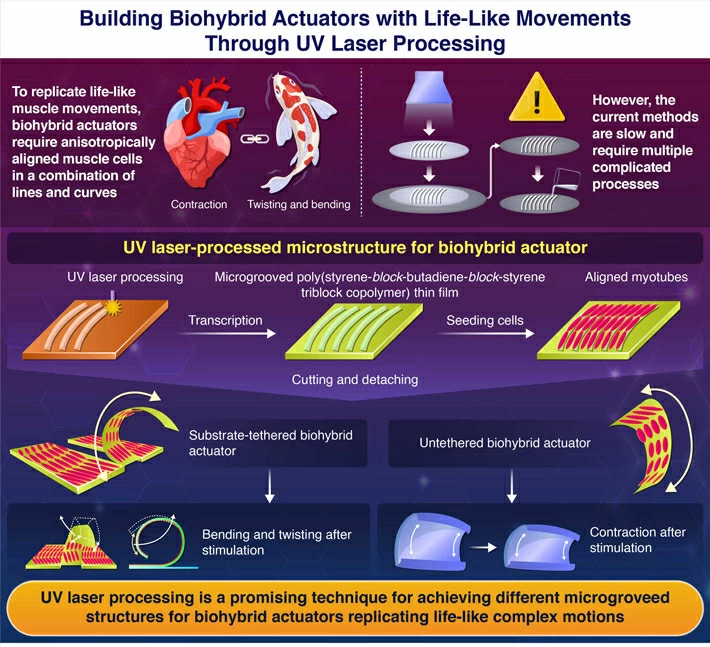Reviewed by Lexie CornerFeb 27 2024
Researchers at Tokyo Tech have demonstrated that ultraviolet-laser processing is a viable method for creating complex microstructures that allow for the sophisticated alignment of muscle cells—a prerequisite for creating life-like biohybrid actuators.
 UV laser-processed microstructure for building actuators with anisotropic movement. Image Credit: Mita et al. (2024) |Biofabrication| 10.1088/1758-5090/ad2080
UV laser-processed microstructure for building actuators with anisotropic movement. Image Credit: Mita et al. (2024) |Biofabrication| 10.1088/1758-5090/ad2080
This novel methodology opens the door to the development of biohybrid actuators that can perform complicated, flexible movements by making it easy and fast to fabricate microstructures with elaborate patterns to achieve various muscle cell configurations, as opposed to existing difficult procedures.
The goal of biomimetic robotics is to replicate the motions and biological processes of living things. This exciting field of study has the potential to improve robot performance while also providing a framework for studying the biology of muscles.
Biohybrid actuators—soft, muscle-like cells that replicate real muscles’ force—can achieve lifelike movements and functions like self-healing, high efficiency, and power-to-weight ratio, which traditional, bulky robots cannot match without heavy energy sources. Arranging muscle cells anisotropically in biohybrid actuators enables these lifelike movements.
While previous studies have reported significant movement in biohybrid actuators using aligned muscle cells, they have focused primarily on anisotropic alignment in straight lines, producing only simple motions rather than the complex twisting, bending, and shrinking of native muscle tissues. Real muscle tissues have complex arrangements of muscle cells, including curved and helical patterns.
The intricate fabrication of complex patterns of microgrooves (MGs) to align muscle cells requires multiple steps with methods like photolithography, wavy micrography, and micro-contact printing. A simpler, faster approach is needed to rapidly create the curved MGs that guide the organized alignment of muscle cells.
To solve this, a group of researchers from the Tokyo Institute of Technology (Tokyo Tech) in Japan has created a method for creating complex microstructures using ultraviolet (UV) laser processing under the direction of Associate Professor Toshinori Fujie from the School of Life Science and Technology.
Based on our previous prototypes, we hypothesized that biohybrid actuators using an SBS (hard rubber) thin film with arbitrary anisotropic MGs fabricated by a UV laser processing can control cellular alignment in an arbitrarily anisotropic direction to reproduce more life-like flexible movements.
Toshinori Fujie, Associate Professor, School of Life Science and Technology, Tokyo Institute of Technology
Their study has been published in the journal Biofabrication.
The new method involves creating curved MGs on a polyimide by UV-laser processing, which is subsequently transcribed onto an SBS thin film. The MGs are used to align the myotubes, which are skeletal muscle cells found in living things, to create an anisotropic curved muscle pattern.
Using this technique, the scientists created two distinct biohybrid actuators: an untethered version and one attached to the glass substrate. Both of the actuators are twisted in response to electrical stimulation. It is interesting to note that the biohybrid actuator’s curved myotube alignment, which mimics a natural sphincter, allowed it to change into a 3D free-standing structure when it was not attached.
Fujie added, “These results signify that compared to traditional methods, UV-laser con is a quicker and easier method for the fabrication of tunable MG patterns. This method raises intriguing opportunities for achieving more life-like biohybrid actuators through guided alignment of myotubes.”
All things considered, this study shows how UV laser processing can be used to create various anisotropic muscle tissue patterns, opening the door to more realistic biohybrid actuators that can perform intricate, flexible movements.
Journal Reference:
Mita, H., et al., (2024) UV laser-processed microstructure for building biohybrid actuators with anisotropic movement. Biofabrication. doi/10.1088/1758-5090/ad2080